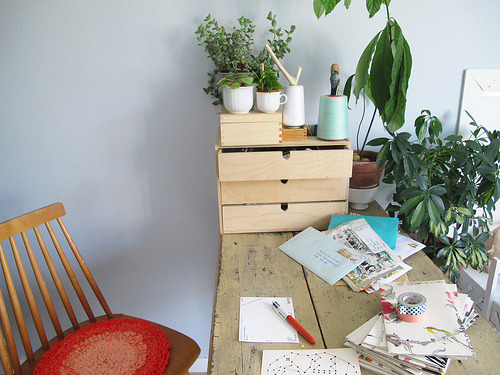Photo

Our little jalapeño bush on the verandah has been pumping out chillies this week! So today we made jalapeño and garlic hummus & it was delicious 👅✌🏼️ #organic #eatwhatyougrow #homemade #organicgardening #growyourown
0 notes
Photo

Looking for treasure after the beautiful rainy weather today ☔️ #beachlife #WA
0 notes
Photo

I spent some time plucking out some baby beetroots & radishes today so the others can grow nice and big & while I was doing that I noticed we have a bit of an infestation of little cabbage moth caterpillars savaging our radishes and tatsoi! I picked off what I could see so hopefully they'll leave us alone for a while... 🐛🔫
0 notes
Text
PLANTING USING CROP ROTATION
A couple of months ago I wrote a post on planning the space for a veggie garden about how I was planning to set up my garden beds, but after a bit more planning and researching I've decided to go with crop rotation set up instead. Crop rotation is a really important part of organic gardening - it helps to protect our environment, can increase fertility in the garden and can help to control pest and disease. Some plants also add nutrients to the soil which will benefit the next plants to occupy that space - so it just makes sense to garden this way, like it was done in the old days!
SO, WHAT GETS PLANTED WHERE AND WHEN?
SOMETHING TO NOTE:
While a lot of these plants fall into the same category of what should grow at what time in the rotation, some shouldn't be grown together due to compatibility issues (ie. some roots don't really like each other). I like to check out Gardenate to see what vegetables grow best together.
WHY THIS WORKS
Growing a large amount of the same fruit or vegetable season after season makes your crops an easy target for pests and disease - a reason commercial growers feel the need to spray. This method of planting also depletes soil nutrients and these are a few reasons why we've decided to go with a crop-rotation plan. As a general rule, crop rotation cycles usually run around four years (or longer) because this is how long it takes the pests and diseases to decrease to harmless levels in the soil. While this method is generally good it doesn't take into account companion planting which is highly beneficial for pest control as well as water, pH and nutrient requirements.
In regards to the flow of the cycle; legumes are 'soil-builders' and fix nitrogen in the soil making perfect conditions for the nitrogen-loving brassicas to occupy that space after the legumes. Root vegetables don't like heavily fertilised soil, making them perfect to follow the brassicas who break down the rich compounds. Because root vegetables break up the soil, they are followed by vegetables that like loose soil and as a general rule, light feeders follow heavy feeders and vice versa.
SO, HOW HAVE WE PLANNED OUR BEDS NOW?
We have decided to go with eight 1.2mx0.9mx0.4m rasied garden beds that we bought from Masters. This is how we've separated the plants and what were growing in each bed:
SOLANACEAE BED #1
Golden Roma Tomato
Red Cherry Cocktail Tomato
Green Zebra Tomato
Rosa Bianca Eggplant
Turkish Orange Eggplant
SOLANACEAE BED #2
Pineapple Tomato
Costoluto Genovese Tomato
Hillbilly Tomato
Cherry Time Capsicum
Sweet Cubanelle Capsicum
Purple Beauty Capsicum
Golden Wonder Capsicum
BRASSICAS BED #1
Red Russian Kale
Black Toscana Kale
Tatsoi
Choy Sum
Bloomsdale Longstanding Spinach
Dandelion Greens
Dov Lettuce
Iceberg Lettuce
Purple Vienna Kohlrabi
BRASSICAS BED #2
Purple Sprouting Broccoli
Di Cicco Early Broccoli
Romanesco Broccoli
Red Dutch Cabbage
Amaranth
NZ Spinach (in a pot to the side)
CURCUBITS BED #1
African Horned Cucumber
Richmond Green Apple Cucumber
Boston Pickling Cucumber
Spaghetti Squash
Rondo de Nice Zucchini
CURCUBITS BED #2
Casaba Golden Beauty Rockmelon
Honey Dew Melon
Pele de Sapo Melon (Christmas Melon)
Sugar Baby Watermelon
CURCUBITS BED #3
Australian Butter Pumpkin
Small Sugar Pumpkin
ROOT CROPS & LEGUMES BED
Winged Bean (Asparagus Pea)
Purple King Bean
Blue Lake Bean
Red Dragon Snake Bean
White Alabaster Celeriac
Chioggia Beetroot
Early Wonder Beetroot
White Beetroot
Amsterdam Carrot
Atomic Red Carrot
Cosmic Purple Carrot
Watermelon Radish
Champion Radish
NOTES:
These beds are just for what's growing now, as different vegetables some in and out of season the beds will change. I was too late to plant any alliums this year and I'm not growing any potatoes but I'm planning to start those next year so I'll mix the beds around a little then and will most likely grow the pumpkins and watermelons straight into the ground to save space. I combined the legumes and root crops this time because they were the only ones that fitted together and I was more interested in getting the other beds right because they're growing the veggies and fruit we use a lot more.
0 notes
Photo

Standing Guard : Nile, Northern Tasmania (Australia) : Jason Stephens
928 notes
·
View notes
Quote
“Empty yourself and let the universe fill you.”
Unknown (via suspend)
92K notes
·
View notes













